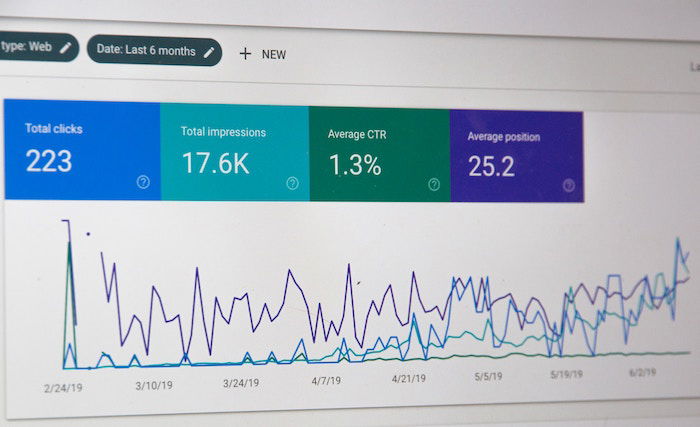Search Engine Optimization (SEO) can help your website rank higher in searches on Google and other major search engines. That’s why SEO for photographers is crucial.
When you rank high for specific keywords, you drive traffic to your website. This can lead to more clients, who wouldn’t have found you otherwise.
Here’s how to use SEO, and use it well, for photography.
The data shows that 60-80% of click traffic goes to the top three search results. People are more likely to refine a search.
They won’t go to the second page if they don't immediately find what they're looking for.
Having good SEO translates into more visitors to your site. This can mean more business for you as a photographer.
Referrals have been the biggest source of business for freelancers. But more and more photographers are now being found through organic searches.
I always make a point of asking new clients how they found me and the answer is often the same. They queried the first several photographers listed in Google.

How Do Search Engines Work?
An estimated 35 trillion Web pages across the Internet worldwide are "indexed" by Google alone. An Index is a huge database of all the content that Google has discovered.
Search engines work in the following ways:
Search engines also pay attention to lots of other "signals". For example, how often the page is updated and if the domain is trustworthy.
There are many search engines to choose from and they all use different algorithms. Some sites may give their results in a different order. Or they may even show completely different results altogether.
It may come as no surprise that Google is the preferred search engine for 90% of users.

What Factors Influence SEO?
More than 200 signals can influence where your webpage shows up in any given search. There are so many signals. No particular signal is likely to significantly affect your SEO on its own.
Signals can be divided into "on-page" factors like HTML architecture. And "off-page" factors, such as your participation in social media.
You have to have the technical part of SEO down. And you also need to have compelling content that brings people to your site.
You need to put marketing efforts into place to show people you exist. This is why content creators such as bloggers spend more time promoting their posts than producing them.
Having good on-page factors alone will not give you good SEO. You can change them or improve upon them right away.
Off-page factors take time to build and the results are more slow to be considered by search engines.

How to Improve Your SEO
The appearance of your website in a search result can influence whether people click on it or not. It also affects its indelibility.
Search your name in Google to see what comes up. You need to see a page title and meta description of your site.
Mine says Darina Kopcok Food Photographer – Food & Lifestyle Photographer in Vancouver, Canada.
Location is very important as you want the people near you to be able to find you.
With some photography driven web builders like PhotoShelter and Format, you can update the page title and meta description in the site builder.
Google will re-crawl and re-index your site within a few weeks.
People are now doing a lot of searching on mobile devices. Google skews its results toward mobile-friendly websites.
Your site might come up number one for a search term from a desktop computer. You won't necessarily be number one in the same search on a phone.
Your photography website must be mobile friendly to be competitive.
"Responsive" websites optimize page design based on the device that is being used to view the content.
You see a single column of content on a phone as opposed to the 2-3 columns of content when viewing on a desktop.
Before you commit to a web builder, make sure it's mobile responsive.
Keywords are a major key to powerful SEO. You need a strategy to use them effectively. This requires research so that you can better understand your target market. And how they are searching for your type of services.
Before you grow through search engine optimization, you have to understand who your clients are. And what they are looking for.
What kind of photographer is your ideal client looking for? Do they want a portrait photographer?
Should that portrait photographer specialise in photographing families? Or are they looking for someone to shoot engagement shots and their wedding?
Will the wedding be a destination wedding?
You may have a way of describing what you do,. But how does your audience actually search for the service you provide? Answering this question is a crucial first step in the keyword research process.
Come up with some keywords that you'd like to rank for. You can enter them into a word research tool. You’ll find similar keywords and average monthly search volume.
You'll discover other keywords that you might have missed otherwise.
Typing "wedding" into Wordtracker, gives you 504+ keyword suggestions. Many of them relevant results for related terms such as wedding dresses.
You'll notice a great variety in search volume of keywords. You want to focus on the terms that your audience is searching for. Be sure to also target terms with lower search volume. They’re far less competitive.
Both high- and low-competition keywords can be helpful for your website. Looking at search volume will help you prioritize keywords.
As a photographer, you're probably a very visual person. You might not think yourself much of a writer. But you should still consider writing a blog.
In my own experience, when I launched a portfolio site, it took me four months to go from page 6 to page 1 in Google searches. Now I am usually number one when you Google food photographer for my city.
I attribute this in part to the SEO that my web builder Photoshelter gives me. Part of it is also because I have a WordPress blog attached to my site.
Blogging on a separate or sub domain from your photography website allows you to build good textual content and backlinks.
You’re in control of your content and the keywords you use to describe your photos. You can link back to specific images or galleries within your website.
This is a crucial step in building overall SEO. Having links to only your homepage will have limited effect.
When you blog you need to have high quality content. Search engines can penalise your domain for duplicate content, excessive backlinks, or broken external links, among other factors.
It's common for photographers to spend time putting together their online portfolio. And then forget about it for months or years afterwards.
Google will often factor in new content when ranking search results.
Shots you took of a celebrity chef in 2014 won't rank well. Make sure to regularly add content to your website to keep your content fresh.
Maintaining a blog is one important way to keep your site updated and your SEO optimized.

Having other sites or blogs to link to you is a great way to boost your SEO. Sites like PetaPixel and FeatureShoot show photographer's work often. This is a great way to build links.
When your work is featured on a popular site, it creates a cascade of links from other sites. Creating backlinks is very important for good SEO. These are links from other websites to your website.
You can also do guest posts on other blogs where you're not in direct competition with the host of the blog.
Once others link to you, make sure that you advertise it on your social media channels. Let other sites know about it too.
You must market everything you do and social media is a great way to do that.
Social media continues to play a crucial role in the many signals that drive SEO. Search engines look at social media platforms like Facebook, Twitter, and Instagram. These are a barometer of what is influential on the Internet.
Love it or hate it, as a photographer, participating in social media is a must. Your social media presence affects your search engine results.
It’s an essential marketing tool. You need to go to where your potential clients are hanging out, and one of those places is social media.
And social media leads to “social proof”. Clients are more likely to buy from you when they have the recommendation of others.
This is why customer reviews on sites like Amazon are so powerful. Trust is an important factor in getting strangers to hire you.
Creating a free Google Business listing is an important step. This allows you to be found in search results. A GMB allows your company information to be output with high visibility in a variety of ways by Google.
When you set up your GMB listing, you'll also have access to Google My Business Insights. This will provide you with detailed information on how and where consumers are searching for your business. You’ll also know how far away they are when looking for directions, and much more.
Combine this with your website's Google Analytics data. It creates an overview of how people find your website and listing and the actions they take afterward.
A large percentage of searches are geography-specific, like "Seattle wedding photographer".
When Google returns results that have a geographic component, Google Maps pack prioritizes them over standard results. This is a set of results plotted on a clickable map.
To get yourself on the map, create a free Google My Business listing, go here.

Google Analytics can provide you with advanced metrics and data about your website traffic. Its data collection and reporting can seem quite complex, especially to beginners.
Google Analytics collects data about your website visitors and their interactions on your website. It uses a small piece of Javascript tracking code.
Interactions are all the types of actions users perform on your website. They can be as simple as loading a page, or something more specific like clicking a link or playing a video.
With each user interaction on your website, the tracking code sends information to Analytics.
This is information about your users and their interactions on your website.
The information sent by the tracking code is called a hit. This is a URL string with parameters of useful information about your users.
After you create your Google Analytics account, you need to add the script on your website.
Google Analytics will drop a cookie in the user's browser for your website. It will help to track every interaction that the user performs on your site.
The information you can gather is as follows:
These metrics are useful to learn about your users. They’ll help you improve your marketing strategies, SEO, and to boost your conversions.
Success with SEO doesn't happen overnight. You need a sustained effort for content building. Combine it with best SEO practices to start appearing on the first results page.
The advantages of doing so are clear. You will generate more organic (aka free) traffic to your website, which could mean a lot more business.